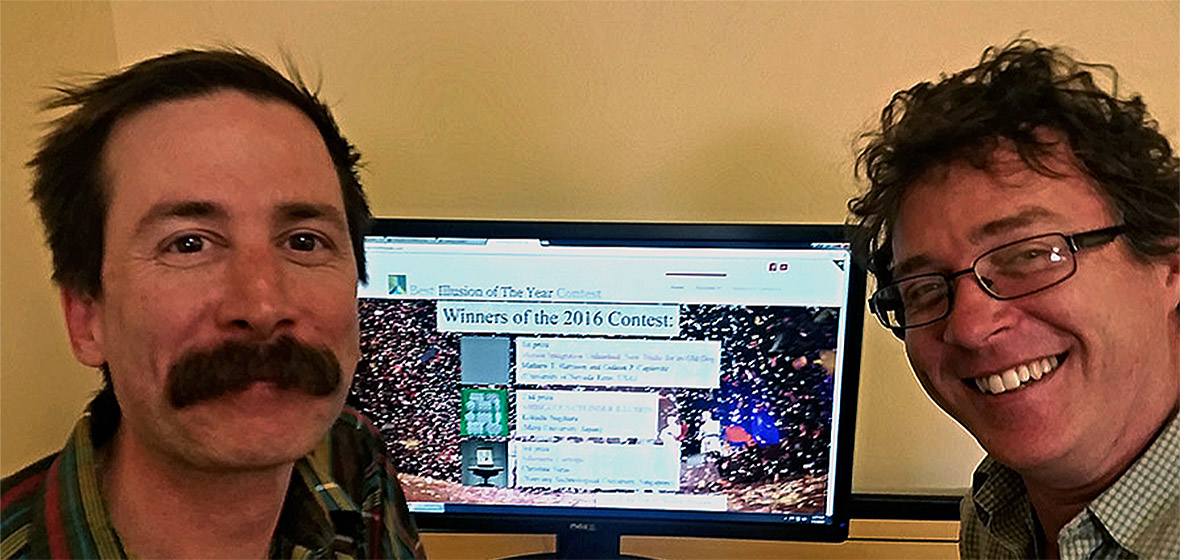Illusions are made with a purpose - to trick the eyes and deceive the brain. The 12th annual Best Illusion of the Year Contest, put on by the Neural Correlate Society, gave researchers from all around the world the chance to submit their illusions in an effort to trick and deceive the minds of online spectators. Gideon Caplovitz, assistant professor of psychology, and graduate student, Matthew Harrison, placed in the Top 10 Best Illusions for 2016 and won first place with their Motion Integration Unleashed: New Tricks for an Old Dog illusion.
The award-winning illusion employs stationary Gabor elements in which drifting gratings produce local motion signals that match those that would be produced if the entire configuration was actually moving.
"When our brain puts these local motion signals together it produces the perception of globally moving shapes, rather than locally drifting elements," Harrison said. "This illusion allows us to examine the contribution of local motion signals to global motion perception independent of actual changes in position."
The Best Illusion of the Year Contest is hosted by the Neural Correlate Society, which is a nonprofit organization. The NCS hosts events like the Best Illusion of the Year Contest to promote public knowledge and medical knowledge by translating new discoveries related to the neural correlates of sensory and cognitive experience. NCS seeks to help increase medical advancement and overall awareness by serving a community of perception scientists, ophthalmologists, neurologists, and artists who use a variety of methods to help discover the foundation of illusory perception.
Harrison and Caplovitz created a one minute video with a catchy tune to present their illusion. After an initial review by impartial judges to narrow down the Top 10 Best Illusions, the voting opened to online viewers. The online voting took place during a 24 hour period, where online viewers ranked the Top 10 Best Illusions on a 10-point scale. The illusion with the most votes was named the Best Illusion of the Year and given $3,000 along with a trophy. The illusion that placed second received $2,000 and the illusion that placed third received $1,000.
Harrison has been working alongside Caplovitz for a little over a year as his graduate student. He is pursuing a doctorate degree in psychology in the Cognitive and Brain Sciences program at the University.
"The program has a strong foundation in the neuroscience of vision, which I found attractive since investigating how the brain produces conscious awareness and perceptions appeals to my philosophical nature," Harrison said. "Ultimately, I want to research and teach much like Caplovitz does, and hopefully half as well."
Caplovitz and Harrison worked on the illusion for two months in the Caplovitz Vision Lab, which is partially funded by the Center for Integrative Neuroscience, a multidisciplinary Center of Biomedical Research Excellence (COBRE) grant. Caplovitz is one of five University faculty members who are part of the $10 million grant awarded to the University in 2012 to foster complementary approaches to understanding the brain and neurological disorders.
This is the sixth year that Caplovitz has had an illusion place in the Top 10 Best Illusions and the second year his illusion placed first. He has worked with various graduate students throughout the years that have helped create illusions in the Vision Lab. Harrison has had the opportunity to create an illusion that placed first out of multiple submissions worldwide during his first year working with Caplovitz. Harrison's time with Caplovitz has given him the chance to advance his career.
"It has been a great year; Caplovitz is a fantastic, insightful and enthusiastic researcher," Harrison said. "This coming year, I am looking forward to working with Caplovitz's friend and frequent collaborator, Dr. Lars Strother."
To learn more about NCS, or to view other illusion submissions, visit the Best Illusion of the Year website. To learn more about Caplovitz and his research visit the University's psychology faculty page.












